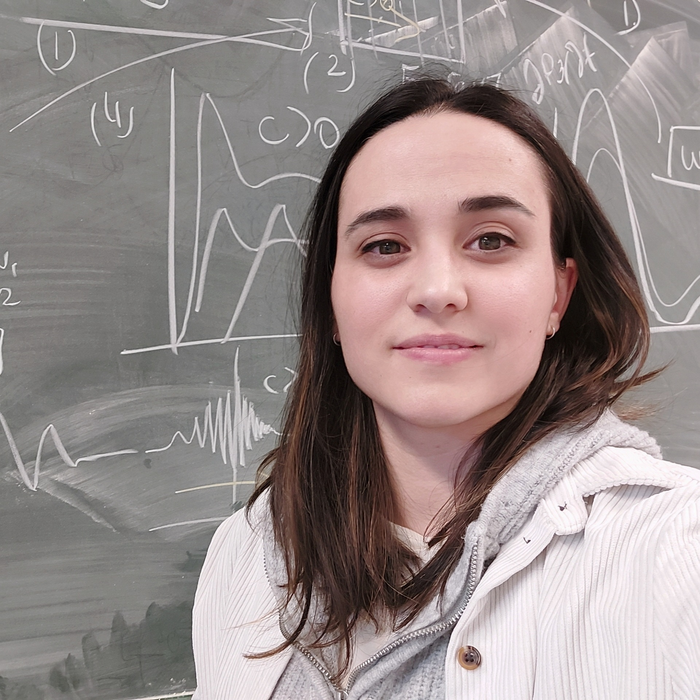In organic solar cells, carbon-based polymers convert light into charges that are passed to an acceptor. This type of material has great potential, but to unlock this, a better understanding is needed of the way in which charges are produced and transported along the polymers. Scientists from the University of Groningen have now calculated how this happens by combining molecular dynamics simulations with quantum calculations and have provided theoretical insights to interpret experimental data. The results were published on 15 March in the Journal of Physical Chemistry C.

Credit: University of Groningen
In organic solar cells, carbon-based polymers convert light into charges that are passed to an acceptor. This type of material has great potential, but to unlock this, a better understanding is needed of the way in which charges are produced and transported along the polymers. Scientists from the University of Groningen have now calculated how this happens by combining molecular dynamics simulations with quantum calculations and have provided theoretical insights to interpret experimental data. The results were published on 15 March in the Journal of Physical Chemistry C.
Organic solar cells are thinner than classic silicon-based cells and they are flexible and probably easier to manufacture. To improve their efficiency, it is important to understand how charges travel through the polymer film. ‘These films are made up of an electron donor and an electron acceptor,’ explains Elisa Palacino-González, a postdoctoral researcher in the Theory of Condensed Matter group at the Zernike Institute for Advanced Materials, University of Groningen (the Netherlands). ‘The charges are delocalized along the entangled polymer chains and transferred from donor to acceptor on a sub-100 femtosecond timescale. So, we need theoretical studies and simulations to understand this process.’
Charge transfer
The system that Palacino-González studied is made up of the plastic semiconductor P3HT as the donor and PCBM, a polymer with a C60 ‘buckyball’, as the acceptor. ‘We wanted to know how charges are conducted through the material to understand how this material captures and transports energy. For if we understand this, it may be possible to control it.’ Experimental studies of the material provide some information, but only on bulk processes. ‘Therefore, we combined molecular dynamics simulations to determine the motion of the molecules in the material with quantum chemistry calculations to atomistically model the donor polymer, using time-dependent density functional theory.’
These theoretical studies were carried out using a donor polymer that was made up of twelve monomers. ‘We focused mainly on the donor to study how the excitations in the material occur.’ The molecular dynamics simulations show the movement in the ground state due to thermal effects. Palacino-González calculated this for a period of 12.5 picoseconds, which sufficed to study the femtosecond charge transfer.
Experiments
‘And the next step was to superimpose the quantum world onto these molecules,’ continues Palacino-González. To do this, she started with dimers. ‘Two monomers next to each other in the polymer chain will interact, they ‘talk’ to each other. This causes a split in the energy levels of the duo,’ Palacino-González explains. She created a ‘fingerprint’ of the dimer’s energy in the shape of a Hamiltonian, a matrix that contains all the information about a molecular system. ‘When two monomers are aligned in a parallel fashion, the two are coupled and talk to each other. But when they are at 90-degree angles, the interaction is minimal.’
Such an angle forms a kink in the molecule, which hampers energy transfer along the polymer chain. ‘A statistical analysis of the simulated material, made up of 845 polymers, shows that around half of them are perfectly aligned, while the other half have mostly one or two kinks,’ says Palacino-González. From dimers, she calculated the Hamiltonian of 12-mers (made up of 6 dimers). Her calculations included a varying number of kinks in the 12-mer donor polymers. ‘These studies show the energy distribution along the polymers and provide us with a realistic model to characterize the effect of the environment created by the materials on the spectral signals of the acceptor polymer blends, which is directly comparable with current experiments on these materials.’
Realistic description
Although the model is limited, since it only allows monomers to interact with their direct neighbour, the results provide important insights into experimental results. ‘Our calculations are from first principles and this is the first time that such an analysis, including the realistic description of the blend environment, was made for this material. This means that we can now help to explain the spectra generated from experimental studies with P3HT/PCBM mixtures. For example, we can show how size distribution changes the spectra that are generated by laser light excitation,’ says Palacino-González. ‘We are now able to look at the ultrafast charge transfer process, from donor to acceptor. This will inspire theoretical studies on organic photovoltaics and help experimentalists to understand their results.’
Reference: Elisa Palacino-González and Thomas L. C. Jansen: Modeling the Effect of Disorder in the Two-Dimensional Electronic Spectroscopy of Poly-3-hexyltiophene in an Organic Photovoltaic Blend: A Combined Quantum/Classical Approach. Journal of Physical Chemistry C, 15 March 2023.
The paper was published in a Special Issue of the Journal of Physical Chemistry C named “Early-Career and Emerging Researchers in Physical Chemistry”. This issue is intended for scientists who have recently begun their independent research careers and are in charge of the development of the work presented in the paper.
Journal
The Journal of Physical Chemistry
DOI
10.1021/acs.jpcc.3c01080
Method of Research
Computational simulation/modeling
Subject of Research
Not applicable
Article Title
Modeling the Effect of Disorder in the Two-Dimensional Electronic Spectroscopy of Poly-3-hexyltiophene in an Organic Photovoltaic Blend: A Combined Quantum/Classical Approach
Article Publication Date
15-Mar-2023
COI Statement
None




